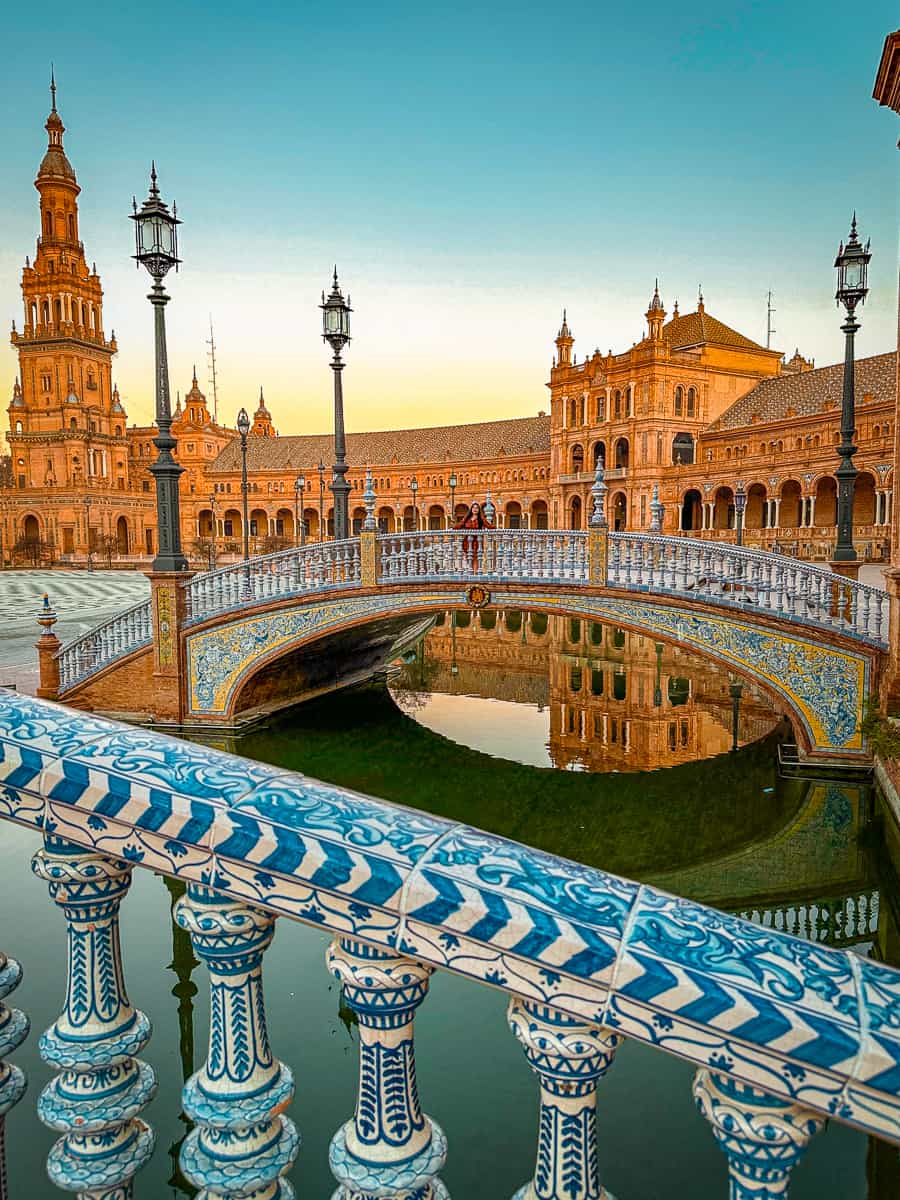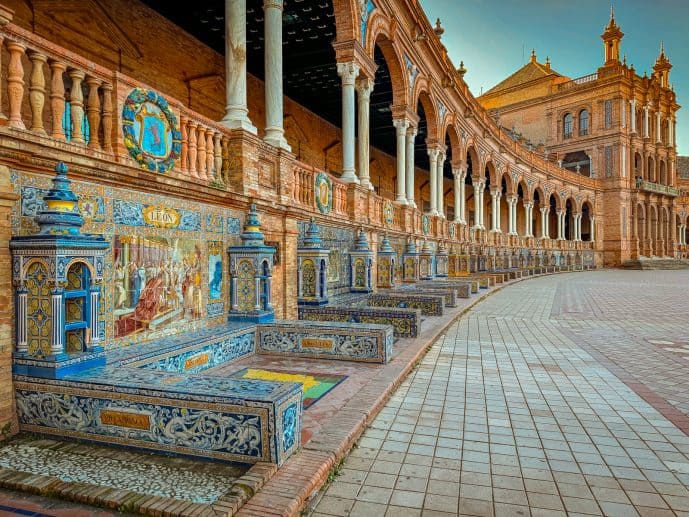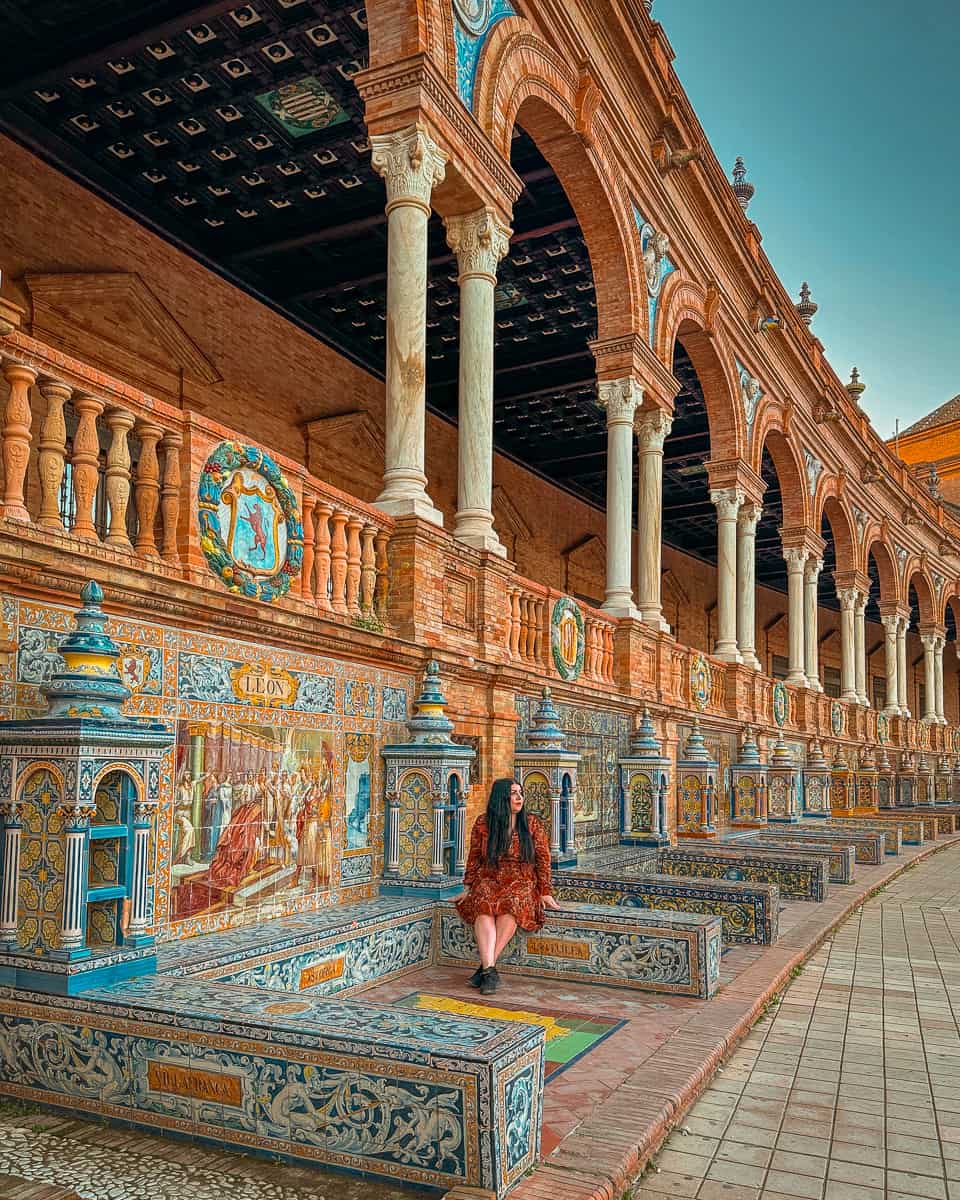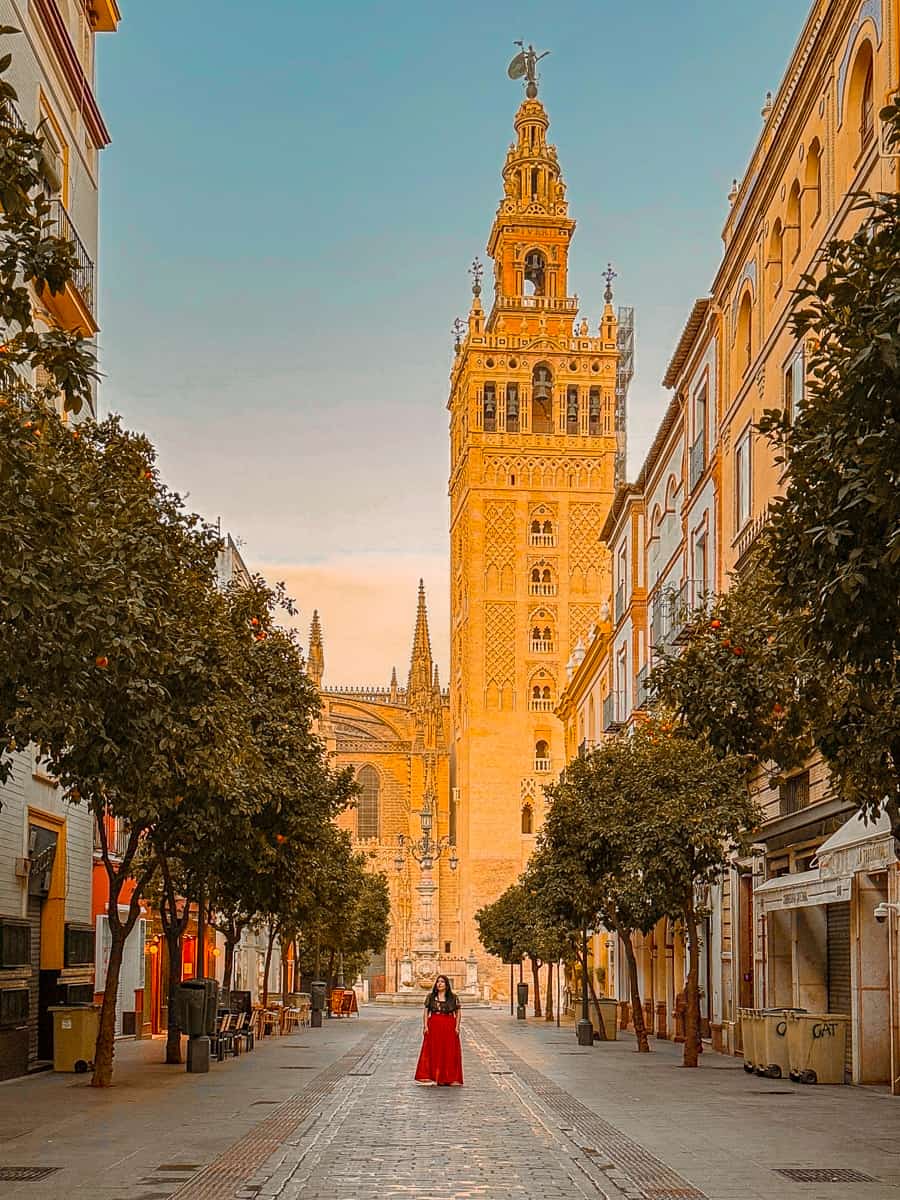This post may contain affiliate links. Please see my disclosure policy for details.
Plaza de España was one of the highlights of my trip to Seville also known as The Spanish Steps.
It’s a huge square with several buildings and monuments constructed for the 1929 Ibero-American exhibition.
On your visit, you can explore the many bridges and tiled alcoves that represent the ancient kingdoms and provinces of Spain and their symbolic peace with former colonies.
Star Wars fans will particularly love visiting as it was a filming location for Theed Palace in Naboo where Anakin and Padmé fall in love during Star Wars II: Attack of the Clones.
As my hotel was near the plaza, I visited this square almost daily during my time in Seville. I just loved the peaceful open space and all the beautiful tile work.
Here is how to visit Plaza de España in Seville and the Naboo Star Wars filming location.

Top Seville Travel Resources
- Book your perfect hotel stay at Booking.com
- Book your tours and attraction tickets with GetYourGuide
- Thinking of renting a car? Look up Rental Cars
- Don’t forget travel insurance, I always use World Nomads
Plaza de España history
The Plaza de España was designed by Aníbal González in preparation for Seville’s Ibero-American Exposition of 1929.
The majority of the fair was to be held in Maria Luisa Park with the plaza being built on the outside to showcase Spain’s industrial and technology exhibits.
This space was designed as a symbol of peace and to inspire friendly relationships between Spain and its former colonies.
Constructed in a Renaissance style, there are several red-brick buildings and towers adorned with ceramic tiles.
Four bridges cross an ornamental moat that represents four ancient kingdoms of Spain and there are vibrant tiled alcoves for each of the Spanish provinces.

It’s 50,000 square metres in total and quite over the top but you cannot deny it’s majestic!
After the exposition, the city decided to keep the square open to the public and recycled the space by installing several government buildings inside.
It underwent a huge multi-million euro renovation and re-opened to the public in 2010. Today, this square is still open to the public and is one of the most popular attractions in all of Sevilla.

Plaza de España Star Wars connection
Beyond being a beautiful attraction in the city, Star Wars fans will love visiting Plaza de España as it was a filming location.
This square was used to film Theed Palace in Naboo during Star Wars II: Attack of the Clones.
Naboo is a peaceful kingdom where Anakin Skywalker and Queen Padmé Amidala fall in love and their romance is one of the most famous of the “Skywalker Saga”.
Their relationship is often scrutinised due to the weird age gap and the fact that Anakin secretly married her, breaking the Jedi code. However, their forbidden romance is still revered by many fans.
Despite the fact that the movie came out almost a quarter of a century ago (!) the couple are still featured in countless memes on social media today.
According to the behind-the-scenes interviews on the DVD (I feel so old), the crew were at Plaza de España for two days to film just over a minute of footage for the movie.
Click here to watch the Star Wars scenes

How to visit Plaza de España in Seville
Plaza de España is a little further out of the historic centre with attractions like the Real Alcazar, Seville Cathedral and Torre de Oro.
It will take you around 20 minutes to walk there from the old town and this is easily done as it’s quite flat.
If it’s too hot or you’d prefer to take public transport, you can take the tram from Plaza Nueva to Plaza de España and the journey is around 20 minutes.
The good news is that once you’re here, there’s lots to do in this area of the city like a wander around Maria Luisa Park!


Things to do Plaza de España
Beyond feeling like you’ve travelled to another planet, there are plenty of things to see and do at Plaza de España.
You could easily spend a couple of hours admiring all the monuments, alcoves and towers.
Plus, there are boat rides, flamenco shows and musicians here throughout the day. Here are all the things to do at Plaza de España;

1. Feel like you’re in Theed Palace in Naboo
If you’re a Star Wars fan, you’ll feel like you’ve entered a Galaxy Far, Far Away in Plaza de España.
You could easily spend time chasing all the Star Wars II: Attack of the Clones filming locations and follow in Anakin Skywalker and Queen Padmé’s footsteps.
The couple first cross the bridge nearest to the South Tower with R2-D2 following close behind. You’ll see the fountain and North Tower in the backdrop.
Then, you can visit the upper arcade gallery and follow the exact route where they walked together nearest the North Tower.
You’ll instantly notice the distinct red brick walkway with archways and ornate buildings behind them.
The entire plaza was used for the establishing scenes of Theed Palace with a little bit of CGI magic. You can get a great view from one of the upper levels in the square.
Related: How to visit the Ahch-To Star Wars filming location from The Last Jedi.

What else has been filmed at Plaza de España?
As well as Star Wars, this incredible square is a popular filming location in Hollywood.
You’ll most likely recognise this plaza from Lawrence of Arabia. It’s won countless prestigious awards and is often voted the greatest movie in cinema history.
They used the Plaza de España for scenes for the Cairo Officers Club. If you’re a fan, you will also find filming locations in Casa de Pilatos and the Alfonso XIII Hotel.
Other movies filmed here include The Dictator starring Sacha Baron Cohen. This is a comedy about Aladeen and his fictional state of Fedijah. The plaza was used as the facade for his palace.

2. Cross the Four Bridges
You’ll notice that the Plaza de España has a water canal that stretches along Avenida Isabella La Catolica and then takes on a crescent moon shape in the complex.
This body of water, or moat, is meant to represent the Guadalquivir River that runs through the city and is known as ‘The Path to America’.
The canal is 515 metres long and you can cross the water by four bridges that represent the four ancient kingdoms of Spain; Aragon, Castile, Leon and Navarra.
If you look at the floor whilst crossing these bridges, each one has a coat of arms and symbols that represent that kingdom!
They are also made with stunning ceramic tiles and make gorgeous photo opportunities.

3. Marvel at the fresco alcoves
The most impressive part of this square, in my opinion, is the beautiful tiled alcoves.
Each one represents a Spanish province and is represented with unique colourful patterns, tiles and maps. They are placed in alphabetical order.
They are all so beautiful and it’s hard to choose a favourite. But, I loved the Malaga alcove as it had a map, coat of arms, vibrant tiles and images of the Reconquista.
Madrid is also a gorgeous alcove and has images of King Ferdinand II of Aragon and Isabella I of Castile.
Each tiled bench is flanked by bookshelves and is meant to have books about the provinces represented in that section. As I visited in winter there were no books, unfortunately!


4. Explore the staircases for panoramic views
There are three large buildings in Plaza de España that have monumental staircases inside. One in the south, one in the centre and one in the north.
You can climb up any of these staircases to the upper levels and get incredible views over the complex from the terraces!
I found that the north was better for views in the morning and the south was better for the afternoon and sunset.
The staircases have beautiful tiled decorations and lanterns inside. You’ll often find musicians and performers inside them too.


5. Torre Sur & Torre Norte
On either end of the Plaza de España, you’ll find two large towers. One is called Torre Sur (South Tower) and the other is Torre Norte (North Tower).
This creates a semblance of balance and was a popular design technique by Italian architect Andrea Palladio. Aníbal González who oversaw the plaza construction was a huge admirer of his work.
You can’t climb up the towers, unfortunately. Most of them are empty save for the entry to government buildings.
But, you can explore the bottom of them and they provide incredible views over the moat. Sometimes they also have vendors inside.

6. Take a boat ride on the moat
The pretty moat here that’s shaped like an eclipse and runs through the plaza is why this area has a nickname ‘The Venice of Seville’.
The waterways are meant to represent the Guadalquivir River which flows through the city.
It’s often thought to be the gateway to America due to the history of Spanish conquest and symbolises the relationship between Spain and the former colonies.
Today, you can take a boat ride on the moat! It’s a very popular activity and can see huge queues in the summer.
The cost is €6 for a 35-minute ride and you must put down a €4 deposit. It’s quite easy to get around the moat within this time but if you overrun the prices go up to €10.
Just note that these are row boats not electric or paddle boats. So, make sure one of you has enough arm strength. I have zero upper arm strength so I was glad to miss out!

7. Vicente Traver fountain
Weirdly enough, the least notable part of the square is the Vicente Traver fountain.
There’s an interesting story about this as the architect Aníbal González didn’t want to install a fountain in the square.
Despite his wishes, the city did install a fountain for the expo after died in 1929 and his family were naturally not happy about this.
So, to make them happy the city installed a statue of Aníbal González near the entrance in his honour….but his face is turned away from the fountain!
Is this a good enough compromise? Probably not. But, either way, the fountain remains here today.
I thought the fountain was the least remarkable part of the plaza. It’s quite plain compared to the other buildings.
Don’t get me wrong, the water show throughout the day is nice to watch and it does light up at night. But, the actual architecture of the fountain wasn’t all that impressive.

8. Watch a Flamenco show
I always found Plaza de España to be vibrant and filled with a buzz of life and culture throughout the day.
If you head towards the centre of the arched gallery, you’ll often find flamenco dancing and these shows always draw in a huge crowd.
The shows usually don’t run on a set schedule and may not take place in bad weather. But, you can often find musicians and dancers here in the late afternoons to evenings.
The dancing, singing and melodies create such a great atmosphere in the plaza! Make sure to have some cash to tip the performers.

9. Avenida Isabella La Catolica
Avenida Isabella La Catolica separates the Plaza de España from Maria Luisa Park and there is always something happening along this street.
Here, you can take a boat ride on the canal, go shopping for souvenirs, take a horse and carriage ride, rent a bike, or get your photo taken as a Flamenco dancer!
There are even lots of street vendors selling ice creams, drinks and snacks. So, leave some time to see what’s going on during your visit.
10. Maria Luisa Park
Just opposite the plaza, you’ll find the large and lush Maria Luisa Park which is located on the Guadalquivir River.
The park used to be part of the Palace of San Telmo but the grounds were donated to the city in 1893 by Infanta Luisa Fernanda, the Duchess of Montpensier.
It was another space in Seville that was renovated for the Ibero-American Exposition of 1929 as the majority of the event was to take place there.
The buildings constructed for the festival still remain here today like the majestic Mudejar Pavilion that now holds the Museum of Arts and Traditions of Sevilla.
You should definitely take a wander around the park if you’re in the area as there are many monuments and things to see.
Highlights included the Pavilion of King Alfonso XII of Spain with the Island of the Ducks, the Fountain of the Lions, the Fountain of the Frogs, Plaza de América and Pavilion Real.

Is Plaza de España free to visit?
Yes, at the time of writing the Plaza de España is completely free to visit. It’s a great budget activity in Seville as there’s so much to do there without spending a single euro cent.
However, the government have been discussing the idea of charging a fee.
Mayor Jose Luis Sanz has said that they want to start charging tourists to finance the plaza’s conservation and safety.

Although it is inconvenient, you can’t really argue with it as much of the square has been damaged over time with missing tiles and damaged facades!
But, this plan to charge has been met with quite a lot of criticism from residents as the plaza underwent a huge renovation just a decade ago.
I guess we’ll have to see if and when this charge comes into place. My thinking is that it will be free to Seville locals but any tourists from outside Seville will pay the fee.

Plaza de España opening hours
Despite the Plaza de España being a free public space, it does have opening and closing times.
You can visit this incredible plaza from 8 am to 10 pm daily in Seville. The complex is gated and locked overnight for security.
The best time to visit would be in the early morning to avoid the majority of the larger crowds and tour groups.
On my first morning, I visited at opening time for photography and there was just a handful of people there at this time. It was mostly joggers and dog walkers.


As my hotel was nearby, I loved going for a walk here in the evenings with all the lanterns lit up over bridges and buildings.
I travelled alone but I felt completely safe in the square at night as there is security around, I can’t say the same for the park nearby. They start ushering people out of the complex around 9.45 pm.
Also, note that the Plaza de España can close without notice. On my visit, we had a day of torrential rain and it was shut for safety.


How long do you need to visit Plaza de España in Seville?
The Plaza de España is a huge complex and roughly the size of seven football pitches. So, you should leave lots of time to explore as there are gorgeous tiles, features and artwork to admire in abundance.
Beyond meandering around the four bridges and admiring all the vibrantly tiled alcoves, there are lots of buildings you can explore in the square that provide incredible panoramic views over the complex.
Flamenco shows take place throughout the day, there are boat rides on offer and even horse and carriage rides.
Personally, I would leave around 2-3 hours to visit Plaza de España.
Plan more time if you want to take a walk around Maria Luisa Park which has even more gorgeous highlights!

What is the best time to visit Plaza de España?
If you wanted to visit for photography or fewer crowds, then by far the best time would be in the early morning.
They do close the gates in the evening for security but you can enter the complex from 8 am. This is when I went and I was pretty much the only person there.
This is perfect in the winter months when sunrise is around that time but in summer you may have lots of harsh shadows already.
By 10 am, this square gets very busy with tour groups and cycle tours. It remains that way until the early evening.


Is Plaza de España worth it?
Yes, the Plaza de España is well worth visiting in my opinion and it was one of the highlights of my trip to Seville.
As someone who loves Azulejo tiles and ceramic artwork, this area was a delight to explore as there were so many beautiful things to see and admire.
I’ve been wanting to visit for years since I first saw it on social media and so I had high expectations. I’m happy to say my visit did not disappoint.
I particularly loved the tiled alcoves and you could spend hours looking at all the small details from each province of Spain.


Star Wars fans will love visiting the Plaza de España as this was the City of Theed in Naboo.
Even though it only appeared for a few minutes, it’s still fun to feel like you’re in a Galaxy Far, Far Away.
Beyond all that, it’s a vibrant area of Seville with lots of things to see and experience like flamenco shows and boat rides with easy access to Maria Luisa Park.
It’s also completely free (for now) – what’s there to lose?!


Looking for more things to do in Seville?
If you love history then Seville has historic attractions in abundance and many are part of the Seville UNESCO World Heritage site!
In the heart of Seville, you’ll find the world’s largest Gothic cathedral and the Giralda Tower. It’s a stunning building that has many features like Christopher Columbus’ tomb and the Capilla Real.
It used to be an ancient mosque and the old minaret tower is now the Giralda Tower. Join the queue to head right to the top and enjoy panoramic views over the city.
The best way to explore this cathedral is on a rooftop tour which is what I did. You’ll get to climb up winding staircases and see the stained glass windows, gothic towers and buttresses up close whilst overlooking the historic quarter.

After you must stop by Archivo de Indias, a huge archive that covers Spanish exploration in the Americas.
After, you must explore the majestic Real Alcazar, the royal palace of Seville. You’ll get to see the Courtyard of Maidens, historic staterooms and the elaborate water gardens too.
For Game of Thrones fans, this is where they filmed the Kingdom of Dorne in the show and you’ll recognise many of the filming locations for Sunspear on your visit.

Although the Alcazar is great, one of my favourite attractions was Casa de Pilatos. An Andalusian mansion with Azulejo tiles and a show-stopping central courtyard.
Seville is the birthplace of Tapas and it’s perfect if you’re a foodie. I would recommend El Rinconcillo which is the oldest tapas bar in the city established in 1670!
Or, why not explore something contemporary and watch the sunset at Setas de Sevilla? It’s a mushroom-shaped structure that overlooks the city and I loved their Aurora show in the evening.

Read more of my Spain travel guides
How to visit Cordoba Mosque-Cathedral for free
Why you shouldn’t skip Casa de Pilatos in Seville
Mirador San Nicholas viewpoint in Granada
Casa Battló – Gaudi’s Dragon House of Bones
30+ Instagrammable places in Barcelona
14+ Things to do in Park Güell
How to visit Bunkers del Carmel in Barcelona
The gorgeous Cascada Monumental
Discover Sant Pau Recinte Modernista
Secrets of Pont Del Bisbe Bridge
How to visit the Kiss Wall Barcelona
Why you must visit the Fairy Bar in Barcelona
You must visit Palau de la Musica Catalana
Save the Plaza de Espana Star Wars filming location for later!

Here are some Spain travel resources
- Flights: I use Skyscanner to look for flight deals. Try to be flexible with travel dates for the best prices.
- Accommodation: Booking.com is my go-to hotel platform and I’ve used them for years.
- Public transport: You can book trains through the official Renfe site. Also, Trainline works and I found it cheaper on some journeys.
- Car rental: Rental Cars is a great choice that compares all sorts of rental companies and gets you the best price.
- Activities: I love GetYourGuide and use the platform all the time for booking group tours and attraction tickets.
- e-Reader: I love to read Romantasy books and I always take my beloved Kindle Oasis with me. It has an orange light and is waterproof which is perfect for lounging by the pool.
- Travel insurance: I always use World Nomads to book travel insurance. You never know when you’ll need cover!
